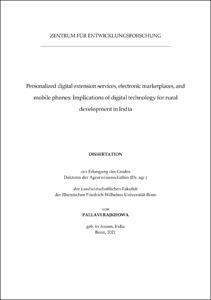Personalized digital extension services, electronic marketplaces, and mobile phones: Implications of digital technology for rural development in India

Personalized digital extension services, electronic marketplaces, and mobile phones: Implications of digital technology for rural development in India

| dc.contributor.advisor | von Braun, Joachim | |
| dc.contributor.author | Rajkhowa, Pallavi | |
| dc.date.accessioned | 2021-12-16T14:38:27Z | |
| dc.date.available | 2021-12-16T14:38:27Z | |
| dc.date.issued | 16.12.2021 | |
| dc.identifier.uri | https://hdl.handle.net/20.500.11811/9489 | |
| dc.description.abstract | In developing countries, the cost of acquiring information is substantially high as information is limited, unevenly distributed, and inefficiently transmitted. Information problems have important consequences on how individuals and markets behave in the absence of perfect information. Often it results in the inability to carry out mutually beneficial exchange and may lead to inefficiencies in the allocation of resources. Under these circumstances, a key policy question for promoting rural development and poverty reduction in the context of developing countries is: how information constraints faced by rural households can be overcome? One potential mechanism to reduce information constraints is the use of digital technologies, which build on information and communication technologies (ICTs) such as internet platforms and mobile phones. In this context, this dissertation empirically analyses the implications of digital technologies on various development outcomes in India.
The first essay focuses on an example of a digital technology that reduces information barriers on the input-side of farm production. Using primary observational data from India, this essay analyses the effects of personalized digital extension services on smallholder agricultural performance. The second essay explores the effects of using a digital tool to connect buyers and sellers in the output market. Using high-frequency monthly data from 2000 to 2017 and applying a fixed-effects approach with Driscoll and Kraay standard errors to deal with spatial and temporal correlation, this essay provides empirical evidence on the effects of the introduction of electronic markets on prices, spikes in prices and price dispersion of an agro-based commodity―tea― in India. Subsequently, the third essay analyses the effect of mobile phones on off-farm employment. Using nationally representative panel data from rural India and regression models with household fixed effects and an instrumental variable approach this essay tests the hypothesis that ownership of a mobile phone increases rural households’ off-farm employment. Finally, the fourth essay analyses the effects of mobile phone on gender outcomes. In many developing countries informal institutions (social and gender norms), structural impediments (inadequate and poor quality of roads and transport systems), and security considerations often restrict women's mobility. In this context, where women are physically and economically isolated, mobile phones promise to be an effective instrument to connect them to markets and services by improving access to information, mobilizing interpersonal networks, influencing attitudinal attributes, and improving physical mobility. Using nationally representative data from India collected in 2011-12 and applying an instrumental variable approach, the results suggest that mobile phones have a positive and significant effect on women's mobility and access to reproductive healthcare services. | en |
| dc.language.iso | eng | |
| dc.rights | In Copyright | |
| dc.rights.uri | http://rightsstatements.org/vocab/InC/1.0/ | |
| dc.subject | Digitale Technologie | |
| dc.subject | Mobiltelefone | |
| dc.subject | Ländliche Entwicklung | |
| dc.subject | Indien | |
| dc.subject | Personalized digital extension services | |
| dc.subject | Electronic marketplaces | |
| dc.subject | Mobile phones | |
| dc.subject | India | |
| dc.subject | Rural Development | |
| dc.subject.ddc | 630 Landwirtschaft, Veterinärmedizin | |
| dc.title | Personalized digital extension services, electronic marketplaces, and mobile phones: Implications of digital technology for rural development in India | |
| dc.type | Dissertation oder Habilitation | |
| dc.publisher.name | Universitäts- und Landesbibliothek Bonn | |
| dc.publisher.location | Bonn | |
| dc.rights.accessRights | openAccess | |
| dc.identifier.urn | https://nbn-resolving.org/urn:nbn:de:hbz:5-64709 | |
| dc.relation.doi | https://doi.org/10.1371/JOURNAL.PONE.0259319 | |
| ulbbn.pubtype | Erstveröffentlichung | |
| ulbbnediss.affiliation.name | Rheinische Friedrich-Wilhelms-Universität Bonn | |
| ulbbnediss.affiliation.location | Bonn | |
| ulbbnediss.thesis.level | Dissertation | |
| ulbbnediss.dissID | 6470 | |
| ulbbnediss.date.accepted | 25.10.2021 | |
| ulbbnediss.institute | Zentrale wissenschaftliche Einrichtungen : Zentrum für Entwicklungsforschung (ZEF) | |
| ulbbnediss.fakultaet | Landwirtschaftliche Fakultät | |
| dc.contributor.coReferee | Qaim, Matin | |
| ulbbnediss.contributor.orcid | https://orcid.org/0000-0002-3265-2420 | |
| ulbbnediss.contributor.gnd | 1250778905 |
Files in this item
This item appears in the following Collection(s)
-
E-Dissertationen (1127)




